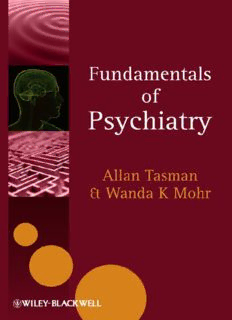
Fundamentals of psychiatry PDF
Preview Fundamentals of psychiatry
Contents Cover Title Page Copyright Dedication Preface Acknowledgments Unit 1: Foundations Chapter 1: Introduction 1.1 Mental Health and Mental Illness 1.2 Incidence and Prevalence of Mental Illness 1.3 Etiology of Mental Illness 1.4 The Burden of Mental Illness 1.5 The Recovery Movement 1.6 Vision of a Transformed Mental Health System Further Reading Chapter 2: The Therapeutic Relationship 2.1 Introduction 2.2 Rapport 2.3 Listening to the Patient 2.4 The Therapeutic Relationship 2.5 Mediating Factors Affecting the Therapeutic Relationship 2.6 Other Issues Affecting the Therapeutic Relationship Further Reading Chapter 3: An Integrative Approach to Developmental Psychopathology 3.1 Introduction 3.2 Toward a Comprehensive, Multidisciplinary Understanding of Psychopathology 3.3 Theories of Development 3.4 Biological Considerations 3.5 Cognitive Development 3.6 Emotional Development 3.7 Social Development 3.8 Moral Development 3.9 The Importance of Identity Formation 3.10 The Emergence of Mental Illness Further Reading Chapter 4: Psychiatric Classifications 4.1 Introduction 4.2 Development of the Diagnostic and Statistical Manual of Mental Disorders 4.3 Nosology, Diagnoses, and the DSM 4.4 Validity, Reliability, and Limitations of the DSM 4.5 The International Classification of Diseases 4.6 Psychiatric Terminology and Accuracy in Communication Further Reading Chapter 5: Psychiatry and the Neurosciences 5.1 Introduction 5.2 Brain Development 5.3 Mind and Brain in Psychiatric Illness 5.4 Other Issues in Neuroscience Further Reading Unit 2: The Context of Care Chapter 6: Care Settings and the Continuum of Care 6.1 Introduction 6.2 Background 6.3 Inpatient Facilities 6.4 Community Support Programs 6.5 Assertive Community Treatment 6.6 Child and Adolescent Service System Programs 6.7 Forensic Settings 6.8 Court Diversion Schemes Further Reading Chapter 7: Cultural Context of Care 7.1 Introduction 7.2 Sociocultural Aspects and Influences 7.3 Culture: The Broad Territory of a Concept 7.4 Gender 7.5 Religion and Spirituality 7.6 Cultural Congruence Further Reading Chapter 8: The Multidisciplinary Treatment Team and Working with Other Professionals 8.1 Introduction 8.2 The Multidisciplinary Team 8.3 Referrals 8.4 Turf Battles 8.5 Courtesies and Professional Relationships Further Reading Chapter 9: Ethical Practice 9.1 Introduction 9.2 Professional Ethics 9.3 Sources of Ethics 9.4 Ethical Behavior of Psychiatric Physicians 9.5 Selected Ethical Issues in Psychiatric Practice 9.6 Rights of Psychiatric Patients Further Reading Chapter 10: Legal Context of Psychiatric Practice 10.1 Introduction 10.2 Hospitalization 10.3 Informed Consent 10.4 Consent to the Treatment of Minors 10.5 Substituted Consent 10.6 Refusal of Treatment and Competence 10.7 Confidentiality 10.8 Responsible Record-keeping 10.9 Lawsuits and Legal Redress 10.10 Liability for Supervising other Professionals 10.11 Criminal Issues Legal Citations Further Reading Unit 3: Clinical Disorders Chapter 11: Pediatric Disorders 11.1 Introduction 11.2 Risk Factors 11.3 Importance of the Family Context 11.4 General Interventions 11.5 Common Psychiatric Disorders Further Reading Chapter 12: Sleep Disorders 12.1 Introduction 12.2 The Physiology of Sleep 12.3 Sleep Hygiene 12.4 Sleep Disorders Further Reading Chapter 13: Bipolar Mood Disorders 13.1 Introduction 13.2 The Bipolar Spectrum 13.3 Etiology 13.4 Course and Prognosis 13.5 Treatments Further Reading Chapter 14: Depression 14.1 Introduction 14.2 Epidemiology 14.3 Etiology 14.4 Signs, Symptoms, and Diagnostic Criteria 14.5 Other Clinical Features in Depressive Disorders and Subtypes 14.6 Differential Diagnosis 14.7 Depressive Disorders with Comorbid Psychiatric Disorders 14.8 Depressive Disorders with Comorbid General Medical Conditions 14.9 Treatments 14.10 Treatment-related Suicidality Further Reading Chapter 15: Anxiety Disorders 15.1 Fear and Anxiety 15.2 Epidemiology 15.3 Etiology 15.4 Panic Disorder 15.5 Obsessive–Compulsive Disorder 15.6 Post-traumatic Stress Disorder 15.7 Acute Stress Disorder 15.8 Social and Specific Phobias 15.9 Generalized Anxiety Disorder Further Reading Chapter 16: Eating Disorders 16.1 Introduction 16.2 Anorexia Nervosa 16.3 Bulimia Nervosa 16.4 Binge-eating Disorder Further Reading Chapter 17: Cognitive Disorders 17.1 Introduction 17.2 The Dementias 17.3 Dementia due to Alzheimer's Disease 17.4 Vascular Dementia 17.5 Dementia due to Huntington's disease 17.6 Dementia due to Lewy-body disease 17.7 Dementia due to Pick's disease 17.8 Dementia due to Parkinson's disease 17.9 Dementia associated with Human Immunodeficiency Virus 17.10 Dementia associated with Creutzfeldt–Jakob disease 17.11 Dementia due to Head Trauma 17.12 Substance-induced Persisting Dementia 17.13 Dementia due to other General Medical Conditions 17.14 Management of the Dementias 17.15 Amnestic Disorders Further Reading Chapter 18: Substance Use, Abuse, and Dependence 18.1 Introduction 18.2 Terminology of Substance Abuse and Dependence 18.3 Recreational Use of Substances 18.4 Epidemiology 18.5 Etiology of Drug and Alcohol Dependence 18.6 Comorbidity and Dual Diagnoses 18.7 Alcohol Use and Dependence 18.8 Hypnotic or Anxiolytic Use or Dependence 18.9 Cocaine Abuse and Dependence 18.10 Amphetamine Abuse and Dependence 18.11 Opioid Abuse and Dependence 18.12 Other Substances of Abuse and Dependence Further Reading Chapter 19: Personality Disorders 19.1 Introduction 19.2 The Categorical–Dimensional Debate 19.3 Epidemiology 19.4 Course 19.5 Etiology 19.6 The Three Clusters of Personality Disorder Further Reading Chapter 20: Stereotyped Movement Disorder and Reactive Attachment Disorder 20.1 Introduction 20.2 Stereotypic Movement Disorder 20.3 Reactive Attachment Disorder Further Reading Chapter 21: Adjustment Disorder 21.1 Introduction 21.2 Diagnostic Criteria 21.3 Epidemiology 21.4 Etiology 21.5 Treatments Further Reading Chapter 22: Impulse Control Disorders 22.1 Introduction 22.2 Impulsivity 22.3 Intermittent Explosive Disorder 22.4 Kleptomania 22.5 Pyromania and Fire-setting Behavior 22.6 Pathological Gambling 22.7 Trichotillomania Further Reading Chapter 23: Mental Disorders due to a Medical Condition 23.1 Introduction 23.2 Clinical Considerations 23.3 Psychotic Disorders 23.4 Mood Disorder with Depressive Features 23.5 Manias 23.6 Anxiety Disorder with Panic Attacks or with Generalized Anxiety 23.7 Obsessive–Compulsive Disorder 23.8 Catatonic Disorders 23.9 Personality Change 23.10 Mental Disorders Not Otherwise Specified Further Reading Chapter 24: Factitious Disorder 24.1 Introduction 24.2 Sick-role Behavior 24.3 Factitious Disorder 24.4 Factitious Disorder by Proxy Further Reading Chapter 25: Schizophrenia and Psychoses 25.1 Introduction
Description: